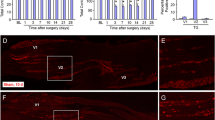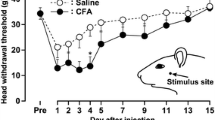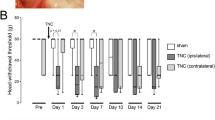Abstract
Recent data demonstrated that chemokine CXCL13 mediates neuroinflammation and contributes to the maintenance of neuropathic pain after nerve injury in the spinal cord. Pro-nociceptive chemokines activate mitogen-activated protein kinases (MAPKs) which are potential signaling pathways contributing to the nociceptive behavior in inflammatory or neuropathic pain. However, whether activation of p38 and JNK MAPK signaling pathway in the trigeminal ganglion (TG) are involved in CXCL13 and its receptor CXCR5-mediated orofacial pain has not yet been clarified. Here, we show that the unilateral partial infraorbital nerve ligation (pIONL) induced a profound orofacial pain in wild-type (WT) mice. Western blot results showed that pIONL induced p38 but not JNK activation in the TG of WT mice. However, the orofacial pain induced by pIONL was alleviated in Cxcr5 −/− mice, and the activation of p38 was also abrogated in Cxcr5 −/− mice. Furthermore, intra-TG injection of CXCL13 evoked mechanical hypersensitivity and increased p-p38 expression in WT mice. But CXCL13 had no effect on pain behavior or p-p38 expression in Cxcr5 −/− mice. Finally, pretreatment with p38 inhibitor, SB203580, attenuated the pIONL-induced mechanical allodynia and decreased the mRNA expression of pro-inflammatory cytokines including tumor necrosis factor-α (TNF-α) and interleukin-1β (IL-1β) in the TG. Taken together, our data suggest that CXCL13 acts on CXCR5 to increase p38 activation and further contributes to the pathogenesis of orofacial neuropathic pain.




Similar content being viewed by others
References
Romero-Reyes, M., and J.M. Uyanik. 2014. Orofacial pain management: current perspectives. Journal of Pain Research 7: 99–115. doi:10.2147/JPR.S37593jpr-7-099.
Zelenka, M., M. Schafers, and C. Sommer. 2005. Intraneural injection of interleukin-1beta and tumor necrosis factor-alpha into rat sciatic nerve at physiological doses induces signs of neuropathic pain. Pain 116(3): 257–263. doi:10.1016/j.pain.2005.04.018.
Gao, Y.J., and R.R. Ji. 2010. Chemokines, neuronal-glial interactions, and central processing of neuropathic pain. Pharmacology and Therapeutics 126(1): 56–68. doi:10.1016/j.pharmthera.2010.01.002.
Cairns, B.E., M. O’Brien, X.D. Dong, and P. Gazerani. 2016. Elevated fractalkine (CX3CL1) levels in the trigeminal ganglion mechanically sensitize temporalis muscle nociceptors. Molecular Neurobiology. doi:10.1007/s12035-016-9935-x.
Yang, Y.J., L. Hu, Y.P. **a, C.Y. Jiang, C. Miao, C.Q. Yang, M. Yuan, and L. Wang. 2016. Resveratrol suppresses glial activation and alleviates trigeminal neuralgia via activation of AMPK. Journal of Neuroinflammation 13(1): 84. doi:10.1186/s12974-016-0550-610.1186/s12974-016-0550-6.
Zhang, Z.J., Y.L. Dong, Y. Lu, S. Cao, Z.Q. Zhao, and Y.J. Gao. 2012. Chemokine CCL2 and its receptor CCR2 in the medullary dorsal horn are involved in trigeminal neuropathic pain. Journal of Neuroinflammation 9: 136. doi:10.1186/1742-2094-9-136.
Gao, Y.J., L. Zhang, O.A. Samad, M.R. Suter, K. Yasuhiko, Z.Z. Xu, J.Y. Park, A.L. Lind, Q. Ma, and R.R. Ji. 2009. JNK-induced MCP-1 production in spinal cord astrocytes contributes to central sensitization and neuropathic pain. The Journal of Neuroscience 29(13): 4096–4108. doi:10.1523/JNEUROSCI.3623-08.2009.
Zhang, Z.J., D.L. Cao, X. Zhang, R.R. Ji, and Y.J. Gao. 2013. Chemokine contribution to neuropathic pain: respective induction of CXCL1 and CXCR2 in spinal cord astrocytes and neurons. Pain 154(10): 2185–2197. doi:10.1016/j.pain.2013.07.002.
Bai, L., X. Wang, Z. Li, C. Kong, Y. Zhao, J.L. Qian, Q. Kan, W. Zhang, and J.T. Xu. 2016. Upregulation of chemokine CXCL12 in the dorsal root ganglia and spinal cord contributes to the development and maintenance of neuropathic pain following spared nerve injury in rats. Neuroscience Bulletin 32(1): 27–40. doi:10.1007/s12264-015-0007-4.
Ji, R.R., R.W. Gereau 4th, M. Malcangio, and G.R. Strichartz. 2009. MAP kinase and pain. Brain Research Reviews 60(1): 135–148. doi:10.1016/j.brainresrev.2008.12.011.
Zhuang, Z.Y., Y. Kawasaki, P.H. Tan, Y.R. Wen, J. Huang, and R.R. Ji. 2007. Role of the CX3CR1/p38 MAPK pathway in spinal microglia for the development of neuropathic pain following nerve injury-induced cleavage of fractalkine. Brain, Behavior, and Immunity 21(5): 642–651. doi:10.1016/j.bbi.2006.11.003.
Huang, Z.Z., D. Li, C.C. Liu, Y. Cui, H.Q. Zhu, W.W. Zhang, Y.Y. Li, and W.J. **n. 2014. CX3CL1-mediated macrophage activation contributed to paclitaxel-induced DRG neuronal apoptosis and painful peripheral neuropathy. Brain, Behavior, and Immunity 40: 155–165. doi:10.1016/j.bbi.2014.03.014.
Jeon, H.J., S.R. Han, M.K. Park, K.Y. Yang, Y.C. Bae, and D.K. Ahn. 2012. A novel trigeminal neuropathic pain model: compression of the trigeminal nerve root produces prolonged nociception in rats. Progress in Neuropsychopharmacology and Biological Psychiatry 38(2): 149–158. doi:10.1016/j.pnpbp.2012.03.002.
Krumbholz, M., D. Theil, S. Cepok, B. Hemmer, P. Kivisakk, R.M. Ransohoff, M. Hofbauer, et al. 2006. Chemokines in multiple sclerosis: CXCL12 and CXCL13 up-regulation is differentially linked to CNS immune cell recruitment. Brain 129(Pt 1): 200–211. doi:10.1093/brain/awh680.
Jiang, B.C., D.L. Cao, X. Zhang, Z.J. Zhang, L.N. He, C.H. Li, W.W. Zhang, et al. 2016. CXCL13 drives spinal astrocyte activation and neuropathic pain via CXCR5. The Journal of Clinical Investigation 126(2): 745–761. doi:10.1172/JCI8195081950.
Zhang, Q., D.L. Cao, Z.J. Zhang, B.C. Jiang, and Y.J. Gao. 2016. Chemokine CXCL13 mediates orofacial neuropathic pain via CXCR5/ERK pathway in the trigeminal ganglion of mice. Journal of Neuroinflammation 13(1): 183. doi:10.1186/s12974-016-0652-1.
Zhuang, Z.Y., P. Gerner, C.J. Woolf, and R.R. Ji. 2005. ERK is sequentially activated in neurons, microglia, and astrocytes by spinal nerve ligation and contributes to mechanical allodynia in this neuropathic pain model. Pain 114(1-2): 149–159. doi:10.1016/j.pain.2004.12.022.
Zhuang, Z.Y., Y.R. Wen, D.R. Zhang, T. Borsello, C. Bonny, G.R. Strichartz, I. Decosterd, and R.R. Ji. 2006. A peptide c-Jun N-terminal kinase (JNK) inhibitor blocks mechanical allodynia after spinal nerve ligation: respective roles of JNK activation in primary sensory neurons and spinal astrocytes for neuropathic pain development and maintenance. The Journal of Neuroscience 26(13): 3551–3560. doi:10.1523/JNEUROSCI.5290-05.2006.
Lees, J.G., S.S. Duffy, and G. Moalem-Taylor. 2013. Immunotherapy targeting cytokines in neuropathic pain. Frontiers in Pharmacology 4: 142. doi:10.3389/fphar.2013.00142.
Xu, L., Y. Huang, X. Yu, J. Yue, N. Yang, and P. Zuo. 2007. The influence of p38 mitogen-activated protein kinase inhibitor on synthesis of inflammatory cytokine tumor necrosis factor alpha in spinal cord of rats with chronic constriction injury. Anesthesia and Analgesia 105(6): 1838–1844. doi:10.1213/01.ane.0000287660.29297.7b. Table of contents.
Lappas, M., M. Permezel, and G.E. Rice. 2007. Mitogen-activated protein kinase proteins regulate LPS-stimulated release of pro-inflammatory cytokines and prostaglandins from human gestational tissues. Placenta 28(8-9): 936–945. doi:10.1016/j.placenta.2007.02.009.
Ansel, K.M., V.N. Ngo, P.L. Hyman, S.A. Luther, R. Forster, J.D. Sedgwick, J.L. Browning, M. Lipp, and J.G. Cyster. 2000. A chemokine-driven positive feedback loop organizes lymphoid follicles. Nature 406(6793): 309–314. doi:10.1038/35018581.
Dauvergne, C., J. Molet, A. Reaux-Le Goazigo, A. Mauborgne, S. Melik-Parsadaniantz, Y. Boucher, and M. Pohl. 2014. Implication of the chemokine CCL2 in trigeminal nociception and traumatic neuropathic orofacial pain. European Journal of Pain 18(3): 360–375. doi:10.1002/j.1532-2149.2013.00377.x.
Pearson, G., F. Robinson, T. Beers Gibson, B.E. Xu, M. Karandikar, K. Berman, and M.H. Cobb. 2001. Mitogen-activated protein (MAP) kinase pathways: regulation and physiological functions. Endocrine Reviews 22(2): 153–183. doi:10.1210/edrv.22.2.0428.
Ji, R.R., and M.R. Suter. 2007. p38 MAPK, microglial signaling, and neuropathic pain. Molecular Pain 3: 33. doi:10.1186/1744-8069-3-33.
Anand, P., R. Shenoy, J.E. Palmer, A.J. Baines, R.Y. Lai, J. Robertson, N. Bird, T. Ostenfeld, and B.A. Chizh. 2011. Clinical trial of the p38 MAP kinase inhibitor dilmapimod in neuropathic pain following nerve injury. European Journal of Pain 15(10): 1040–1048. doi:10.1016/j.ejpain.2011.04.005.
Wen, Y.R., M.R. Suter, R.R. Ji, G.C. Yeh, Y.S. Wu, K.C. Wang, T. Kohno, W.Z. Sun, and C.C. Wang. 2009. Activation of p38 mitogen-activated protein kinase in spinal microglia contributes to incision-induced mechanical allodynia. Anesthesiology 110(1): 155–165. doi:10.1097/ALN.0b013e318190bc16.
Taves, S., T. Berta, D.L. Liu, S. Gan, G. Chen, Y.H. Kim, T. Van de Ven, S. Laufer, and R.R. Ji. 2016. Spinal inhibition of p38 MAP kinase reduces inflammatory and neuropathic pain in male but not female mice: sex-dependent microglial signaling in the spinal cord. Brain, Behavior, and Immunity 55: 70–81. doi:10.1016/j.bbi.2015.10.006.
Han, S.R., G.Y. Yang, M.H. Ahn, M.J. Kim, J.S. Ju, Y.C. Bae, and D.K. Ahn. 2012. Blockade of microglial activation reduces mechanical allodynia in rats with compression of the trigeminal ganglion. Progress in Neuropsychopharmacology and Biological Psychiatry 36(1): 52–59. doi:10.1016/j.pnpbp.2011.10.007.
Kiyomoto, M., M. Shinoda, K. Honda, Y. Nakaya, K. Dezawa, A. Katagiri, S. Kamakura, T. Inoue, and K. Iwata. 2015. p38 phosphorylation in medullary microglia mediates ectopic orofacial inflammatory pain in rats. Molecular Pain 11: 48. doi:10.1186/s12990-015-0053-y.
Tong, S.E., S.E. Daniels, P. Black, S. Chang, A. Protter, and P.J. Desjardins. 2012. Novel p38alpha mitogen-activated protein kinase inhibitor shows analgesic efficacy in acute postsurgical dental pain. Journal of Clinical Pharmacology 52(5): 717–728. doi:10.1177/0091270011405496.
DeLeo, J.A., and R.P. Yezierski. 2001. The role of neuroinflammation and neuroimmune activation in persistent pain. Pain 90(1-2): 1–6.
Binshtok, A.M., H. Wang, K. Zimmermann, F. Amaya, D. Vardeh, L. Shi, G.J. Brenner, et al. 2008. Nociceptors are interleukin-1beta sensors. The Journal of Neuroscience 28(52): 14062–14073. doi:10.1523/JNEUROSCI.3795-08.2008.
Gudes, S., O. Barkai, Y. Caspi, B. Katz, S. Lev, and A.M. Binshtok. 2015. The role of slow and persistent TTX-resistant sodium currents in acute tumor necrosis factor-alpha-mediated increase in nociceptors excitability. Journal of Neurophysiology 113(2): 601–619. doi:10.1152/jn.00652.2014.
Acknowledgements
This study was supported by the National Natural Science Foundation of China (NSFC 31371121 and 81300954), the Natural Science Research Program of Jiangsu Province (13KJB180017), and the Priority Academic Program Development of Jiangsu Higher Education Institutions.
Author information
Authors and Affiliations
Corresponding author
Ethics declarations
Conflict of Interest
The authors declare that they have no conflict of interest.
Additional information
Qian Zhang and Ming-Di Zhu contributed equally to this work.
Rights and permissions
About this article
Cite this article
Zhang, Q., Zhu, MD., Cao, DL. et al. Chemokine CXCL13 activates p38 MAPK in the trigeminal ganglion after infraorbital nerve injury. Inflammation 40, 762–769 (2017). https://doi.org/10.1007/s10753-017-0520-x
Published:
Issue Date:
DOI: https://doi.org/10.1007/s10753-017-0520-x




